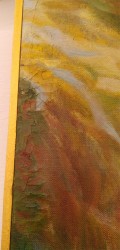The deterioration of paintings in the National Gallery has been caused by artists failing to use the correct wood to frame their work, says the Chairman of the Management Committee of Castellani House Albert Rodrigues, in the wake of criticism from a prominent artist about the poor state of the pieces.
Recently, Guyanese artist Bernadette Persaud condemned the poor conditions in which paintings were stored at the gallery. She publicly criticized the gallery at the opening ceremony of the 2014 Independence Art Exhibition held at Castellani House two weeks ago.
Persaud, in an interview with Stabroek News, stated that some of her pieces had suffered from termite damage while being housed at the gallery. She said she was appalled to see her pieces “tattered,” “cracked up” and “eaten up” by the insects.

“I was concerned about the condition of my works and the works of other artists which were stored in the National Gallery. I wanted them to be photographed and have visits with my students but couldn’t.” She said her works had been inaccessible to students and reporters for some time, and she was shocked to see their state.
Persaud related that one of her pieces ‘Locus of July’ was housed in State House during the time of President Bharrat Jagdeo but was removed and sent back to the National Gallery after it became infested with wood ants.
She said when she saw the painting she noticed that the canvas around the stretcher had been eaten up. “It fell from the wall in the State House and was returned to the National Gallery. The wood was rotten. The edges were tattered and the frame was so soft it could have broken off. I was horrified,” she said.
“If wood ants were attacking the works then they have the duty to monitor all works in the gallery. For three to four years the painting was propped up on a wall at Castellani. The painting was neglected I can only imagine what happened to the other paintings from other people.”

She said some of the paintings were housed in hot rooms which were accelerating the rate of deterioration, adding that the old colonial house was not the ideal home for artistic pieces. “This is a colonial building that is battling with termites and there are nearly 700 pieces of work,” she said.
“What’s the use they are curating exhibitions and they are dealing with wood ants. They need to be more careful and vigilant,” she said, noting that it was the obligation of the Gallery to fumigate the pieces that were bought and inspect the woodwork.
“How can you buy pieces for so much money and not inspect it or conserve it?” she queried. “They buy the work because they think it is a good piece and it’s their duty to preserve it. This is the neglect in dealing with people’s work. There is no control environment and plenty neglect,” she said.
Unfair criticism
Critics have since said that there were other pieces which were decaying in the gallery. But Rodrigues’ view was that it was the artist’s responsibility to ensure that they used the right wood when framing their paintings. He said often artists would not pay enough attention to the materials used in their work.
“I didn’t think it was advisable to object to what she was saying at that time,” he said, responding to Persaud’s accusation against the Gallery. “We have enormous respect for Mrs Persaud but I didn’t think it was the place for her to go off on a critical tour of Castellani House. What she said regarding the condition of the works was unbalanced,” he said.
He explained that he had collected art work from Dudley Charles which had been painted in the mid-1980s and some of it had deteriorated while some remained intact. He said the reason why a few of the pieces deteriorated is because the wood used to frame the paintings was softer.
He said there were internal termites, only detected when the canvas is removed from the frame, which would cause major damage to pieces. “If those frames had not been treated thoroughly with an anti-termite chemical then the pieces would be affected. Most timber undergoes surface treatment. It is unfortunate that termites were eating up the paintings,” he said.
However, he continued, “I have no control over what the artist used before. Most artists do not come with their work adequately framed and treated. Some of them use soft wood instead of hard wood,” noting that it was advisable that paintings be pretreated before they were placed in the gallery.
Rodrigues also observed that since they had received a lot of work dating back to the 1950s they had “inherited” a lot of problems. He said that when they acquired the collection in the early 1990s some of the works were infested and needed repair.
“If you are going to criticize people for not doing anything then you should look at the challenges that is preventing these things from happening. We have the priority to preserve the works but we are limited by our finances. We have to look at what our country can afford… How do you justify taking money away from education, health and other matters of state to build a beautiful national gallery?”
The chairman further stated that since the building was wooden it placed extra pressure to conserve paintings and other artistic works. He said he was very conscious of its state. “If a fire starts a substantial part of the national heritage would be lost along with the building. It is dangerous to store all of the paintings in one place.”
In an attempt to prevent such loss, he explained, some paintings which were not on display were relocated to two garages in the compound. He said that they were also looking to install air conditioning in the garages; however, they would not be installing it in the gallery itself because they would have to consider the pieces being affected by fungus. Despite critics saying that the gallery is hot and not a good place for the pieces, he said, it is actually very airy.
“The priority is not to have all our works in one fragile building,” Rodrigues said, noting that they are improving storage conditions.
He went on to say that since the Culture Ministry had taken control of the building, Minister Frank Anthony had displayed a proactive approach to improving conservation in the gallery, and there had been many consultations between Castellani House and the ministry. He also said Castellani had contracted a company to termite-proof the building.
Acting Curator of the gallery, Ohene Koama reiterated Rodrigues’ comment that many of the artists were not aware of the right methods and materials for framing pieces. He also said that when the most of the collection came to Castellani House it was already 43 years old and had never undergone any kind of conservation.
“When it came we had to get insecticide companies to treat the termites feasting on the pieces,” he said, adding that they recognized the need to conserve the pieces in 1995. He stated that a conservationist from the US had completed a conservation report on the pieces and said the building had to be transitioned into a gallery where the works could be displayed. “However there was no qualified person on staff to conserve the works,” he added.
Koama said the gallery was identifying and quarantining pieces which were infected so as to preserve other pieces.
The gallery is expected also to implement a new policy whereby frames would be changed in cases where they identify that these were not good when purchased from the artist.
“Ideally we would like artists to have the right materials, so it’s unfortunate that we have to replace it,” he said.




